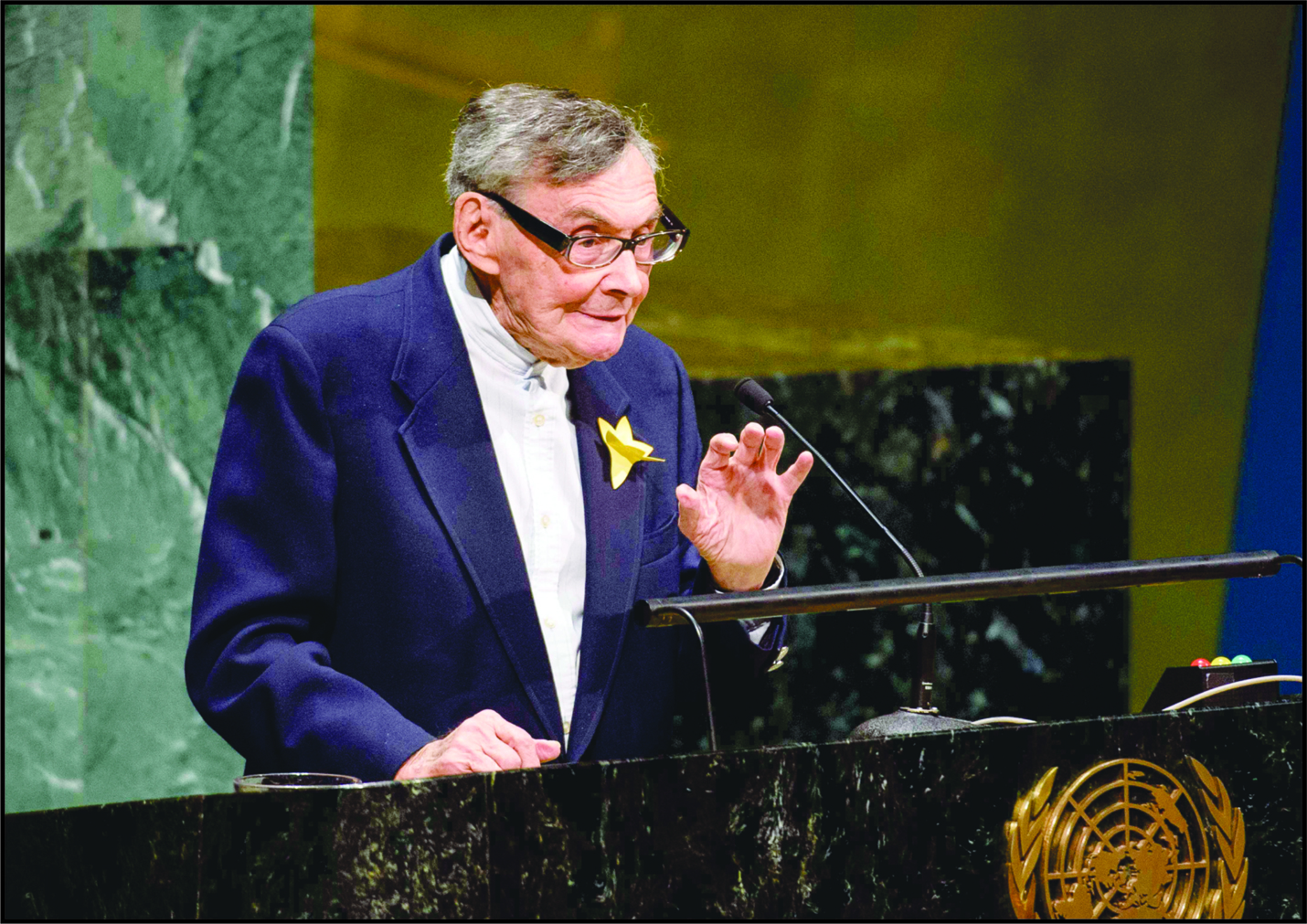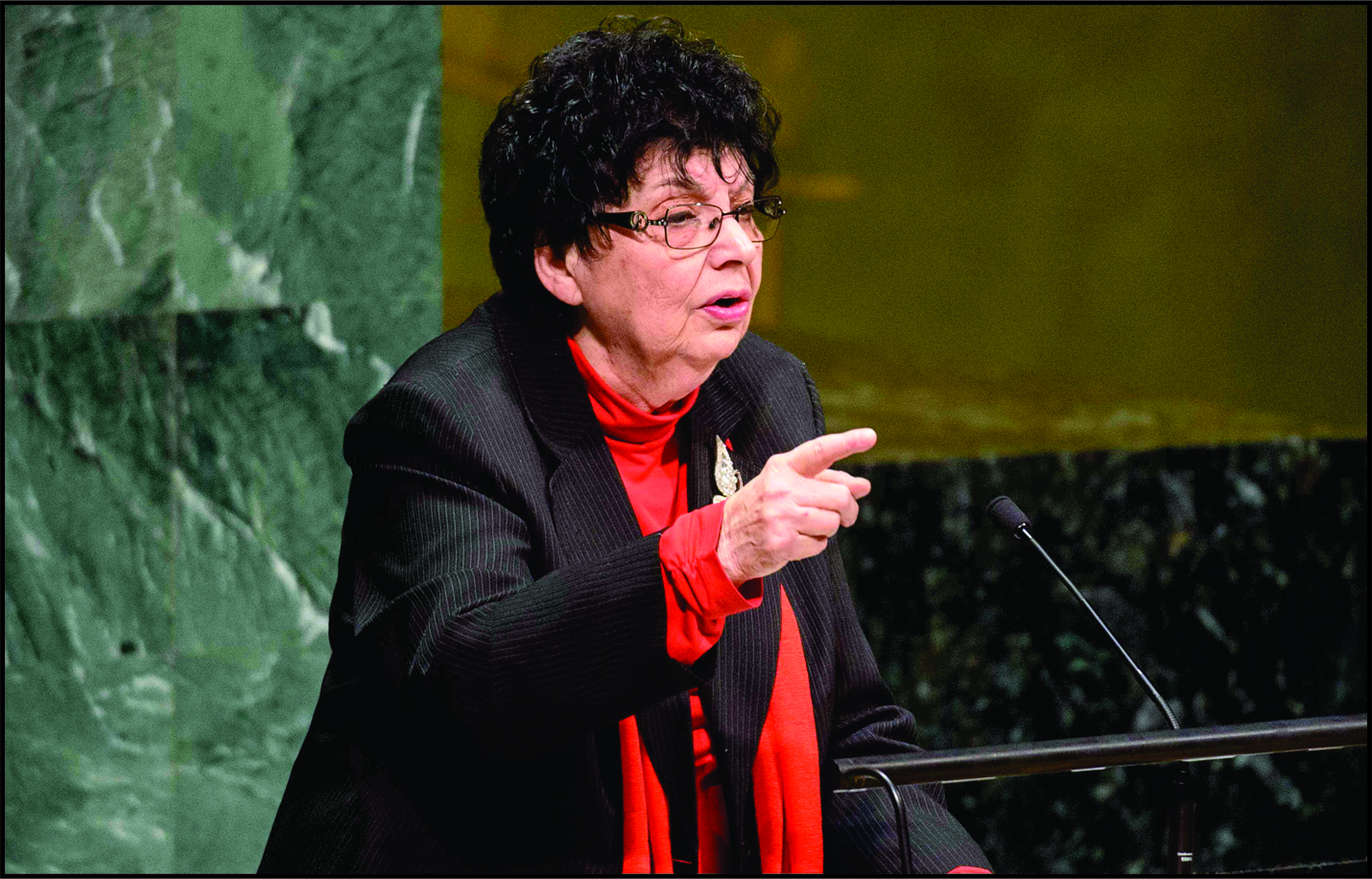Remarks by Marian Turski,
Holocaust Survivor at UN Holocaust Remembrance Ceremony

Marian Turski, Holocaust Survivor & Chair of Museum of History of Polish Jews, addresses the UN Holocaust Remembrance Session.
Photo: Courtesy UN
March 8, 2019
In Auschwitz I had no one. In Auschwitz I had nothing, but a number ... B9408 tattooed on. I was in Auschwitz to the last days, to the Death March to Buchenwald. Then I was privileged in time of war to go on a second Death March from Buchenwald to Theresienstadt where I was liberated the same day as Inge Auerbacher.
I meet people and they used to ask a question. Tell us what was the worst in Auschwitz when you were there. They expect a response. People today, if they are not survivors of the Gulag, if they do not live in Yemen or Sudan, if they have not lived with a larger or smaller portion of nourishment, they cannot imagine what is hunger.
I would say this was not the worst. So, what is worse?
The last winter of 1945 was extra ordinary cold, -20 centigrade, and we were in our inmate quarters and inmate uniforms and I covered a cement sack over and under me and a German supervisor noticed it and shouted "you stole German property" and gave me a savage beating. So, was cold the worst? Not cold, not hunger.
We were settled in barracks, 800, 1000, 1200 people. You are jammed 5,6,7 people in a bunk - so we think do we settle on top bunk or bottom bunk. Top is better because if you have to leak it is better on top. But, when there is roll call there is a danger getting down, we are weak and must speed up to report. But even that is not the worst.
Maybe lice. No possibility of cleaning up or washing. In my last Death March I was infected and ended up the war with typhus. But still I wouldn't say this was worst.
So, what was worst?
Worst was humiliation. If you were Jewish you were treated not like human being. You were treated like a louse, like a bedbug, like a cockroach. And what do decent people do with a louse, a bedbug, a cockroach ... they step on it, they crush it, they suffocate, they kill, they annihilate.
Dear friends, very often I must relate, you who survived the hell, what did you learn from your experience? What would you like to tell us, those people alive today?
If I had to choose among all the lessons and all the words, one or two, I would choose the following ... empathy, Compassion. This is the most important in life.
Dear friends, we today commemorate the anniversary of the liberation of Auschwitz and therefore it's natural that you more and more use the phrase never more, never again, never again Auschwitz. But if we want that this call is not only a mere slogan, an empty phrase, we have, we must, we should, maybe learn from other people ... people who act different from us, who are motivated in their way of life different than you and I are, that we are together. If this is the only way, I think so, that I as a survivor tell something to suggest it , to advise you.
Two days ago I was honored to go to Rabbi Arthur Schneier's synagogue along with many UN diplomats. In a very touching speech Rabbi Schneier used the biblical phrase "and you should love your neighbor like yourself." I would not go as far as Rabbi Schneier. Before you start with love, start with help, respect, discussing, with lessening hatred and hostility. We must do this. If not, who will protect our children and our grandchildren from a worse disaster, from a worse catastrophe?
Remarks by Inge Auerbacher,
Holocaust Survivor at UN Holocaust Remembrance Ceremony

Inge Auerbacher, Holocaust Survivor, delivers her remarks during the United Nations' Holocaust Remembrance Ceremony session in New York.
Photo: Courtesy The UN
March 8, 2019
Thank you United Nations for giving me the honor to address you and the world:
Who am I?
I am One and a Half Million Silent Girls and Boys,
I am here Today to be their Voice.
I was born on Dec. 31, 1934 to a religious Jewish middle class family in Kippenheim; a village in south western Germany. I remained an only child. Papa had served in the German Army in WWI; was wounded and decorated with the Iron Cross. Our world crashed when my parents and I were included in the August 22, 1942 transport from Stuttgart to Terezin (Theresienstadt in German) concentration camp in Czechoslovakia.
I was 7 years old wearing a Yellow Star, and was given the number XIII -1-408; the youngest in the group of close to 1200 people. I arrived with few belongings and my beloved doll Marlene in my arms. Terezin was an old fortress town converted into a concentration camp.
It was sealed off from the outside world with high brick walls, wooden fences, barbed wire, and in control by an SS Kommandant. It was called a Model Ghetto for propaganda purposes. Among the prisoners were the elderly and prominent Jews. They came from Czechoslovakia, Germany, Austria, Holland, and Denmark.
Terezin actually was a holding area before sending the inmates to be killed in the gas chambers of Auschwitz and other killing centers.
The camp was beautified for the International Red Cross Inspection in the summer of 1944. They sadly accepted the deception.
Life was especially harsh for children. We slept on the floor, or if lucky on straw-filled mattresses packed like sardines on double and triple- deck bunk beds. We grew up fast.
The most important words in our vocabulary were bread, potatoes and soup. We got used to the carts piled with dead bodies. Three times a day we stood in long lines holding our metal dishes to get our meager food rations. Hunger, over-crowding, bad hygiene, mice, rats, fleas, bed bugs, lice, and fear of being sent to the East plagued us daily.
We were finally liberated on May 8, 1945 by the Soviet Army. I was 10 years old. I had spent 3 years in this hell. About 144,000 people had been sent to Terezin. Of those 88,000 were sent mainly to Auschwitz to be killed and 33,000 died of starvation and diseases.
Of 15,000 children sent to Terezin very few survived. Most were sent to Auschwitz to their death; including my best friend and bunkmate Ruth. We returned to Germany for less than a year and emigrated to America in May, 1946. We had lost 20 family members; including my beloved Grandma. Of our transport to Terezin only a handful had survived; including my parents and I.
Our destination was New York. Unfortunately my new-found freedom was short-lived, and I became very ill from the consequences of my life in Terezin. I was diagnosed with a severe case of tuberculosis of both lungs.
Years of hospitalization and complete bed rest, plus painful procedures followed. Finally, drugs were discovered to give me a cure.
During my long illness I found solace in writing, which gave me a purpose in life and took away the loneliness I was feeling.
Eventually, I returned to school at age 15, after the loss of 8 years of education. I attained a college degree in chemistry, and worked for 38 years in the medical field. 6 published books followed; including I am a Star - child of the Holocaust.
I am immensely grateful to my co-writer - composer Madeline Stone, and choral director Gregg Breinberg of PS 22 in Staten Island. Special thanks go to the wonderful children of the choir who personify the blending of many ethnic backgrounds.
Thank you all for bringing our song: Who am I to life. My hope my wish and prayer is for every child to grow up in peace without hunger and prejudice.
I plead with you world: Make good choices. The antidote to hatred is education. No more genocides and another Holocaust, and no more anti-Semitism.
Thank you.
